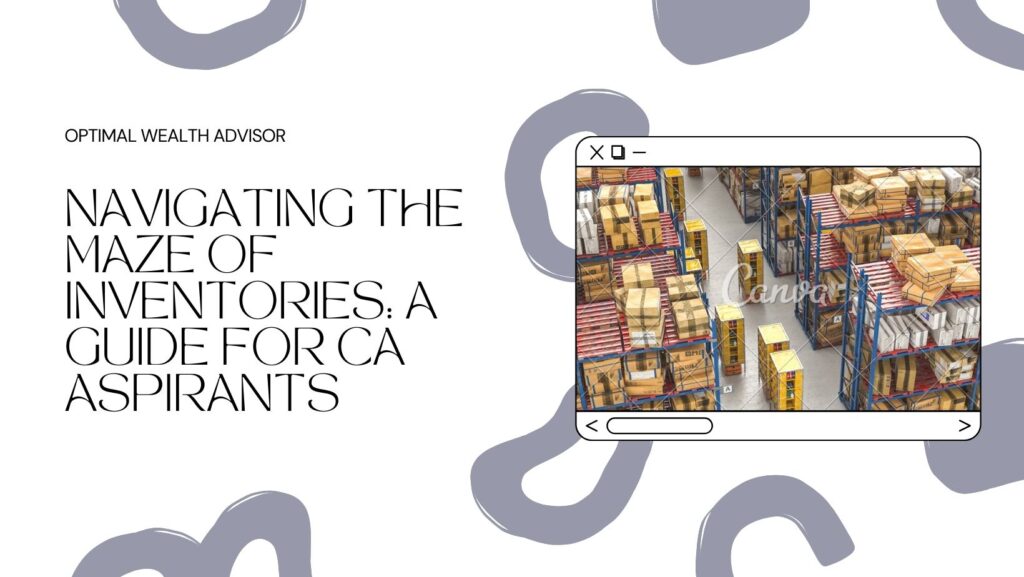In the realm of accounting, inventories play a crucial role in depicting a company’s financial health. Understanding how they are valued and accounted for is essential for aspiring Chartered Accountants (CAs). This blog post serves as your one-stop guide to Ind AS 2, Inventories, specifically tailored for CA Inter and Final aspirants. We’ll delve into the standard’s core principles, explore its key requirements, and equip you with practical insights through real-world examples.

Table of Contents
What is Ind AS 2?
Ind AS 2, an Indian Accounting Standard, dictates the accounting treatment for inventories. It prescribes how companies should recognize, measure, and report these assets in their financial statements. Essentially, it ensures transparency and consistency in how companies present their inventory holdings, allowing for better financial analysis and decision-making.
Objectives of Ind AS 2:
- Accurate Financial Representation: To ensure that the value of inventories is accurately reflected in the financial statements, thereby providing a faithful portrayal of the company’s financial position and performance.
- Consistency and Comparability: To promote consistency in how entities account for inventories, enabling better comparability of financial statements across different companies and industries.
Key Requirements of Ind AS 2:
- Recognition: Inventories are recognized only if they are:
- In the regular course of business, held for sale
- While producing for this kind of sale
- in the form of supplies or resources that are used in the course of providing services or manufacturing goods
- Measurement: The cost of inventories is determined based on all expenditures incurred to bring the items to their present location and condition. This includes:
- Purchase price, import duties, and non-refundable taxes
- Costs directly attributable to bringing the items to their ready-to-use state (e.g., transportation, handling, and storage)
- Abnormal waste, storage costs, and other costs directly attributable to bringing the items to their present location and condition (under specific circumstances)
- Subsequent Measurement: Inventories are subsequently measured at the lower of cost and net realizable value (NRV). The expected selling price in the regular course of business less the estimated completion and disposal costs is the net present value, or NRV.
Understanding Lower of Cost and NRV:
Imagine a company purchases 100 units of a product at a cost of ₹10 per unit. However, due to a sudden market shift, the selling price of the product drops to ₹8 per unit. In this scenario, applying the lower of cost and NRV principle would require the company to value the inventory at ₹8 per unit, reflecting the potential loss in value.
Detailed Example:
ABC Ltd., a manufacturing company, incurs the following costs for 1,000 units of raw material:
- Purchase price: ₹5,000 per unit
- Import duty: ₹100 per unit
- Transportation cost: ₹20 per unit
Calculation of Cost per Unit:
Cost per unit = Purchase price + Import duty + Transportation cost = ₹5,000 + ₹100 + ₹20 = ₹5,120
Therefore, the cost of each unit of raw material for ABC Ltd. is ₹5,120.
Key Takeaways:
- Ind AS 2 emphasizes the accurate and consistent accounting treatment of inventories, crucial for financial reporting.
- Understanding the recognition, measurement, and subsequent measurement requirements is essential for accurate financial statements.
- The lower of cost and NRV principle ensures that the potential loss in value of inventories is reflected in the financial statements.
Frequently Asked Questions (FAQs):
- What are the different methods allowed for cost determination under Ind AS 2?
The standard allows for the use of various methods, such as:
* First-In, First-Out (FIFO)
* Weighted Average Cost (WAC)
* Specific identification (for certain high-value or unique items)
The chosen method should be consistently applied and reflect the company’s specific inventory flow.
- What happens if the NRV of an inventory item increases in a subsequent period?
The inventory value is not adjusted upwards to reflect the increased NRV. The standard focuses on recognizing potential losses, but not unrealized gains.
- How are the costs of storage and handling of inventories treated under Ind AS 2?
These costs are typically included in the cost of inventories, except under specific circumstances where they are considered abnormal or not directly attributable to bringing the items to their present location and condition.
Conclusion:
By mastering the intricacies of Ind AS 2, CA aspirants gain a valuable edge in their professional journey. A thorough understanding of inventory accounting
principles equips them to:
- Analyze financial statements effectively: Accurately interpret the value of inventories reported by companies, enabling them to assess their financial health and performance.
- Prepare accurate financial statements: Apply the provisions of Ind AS 2 to ensure proper accounting treatment of inventories in their own work.
- Contribute meaningfully to various accounting and financial tasks: Understand the impact of inventory valuation on financial ratios and other key metrics, allowing them to provide valuable insights to stakeholders.
Remember that mastering this important accounting standard will require regular practice and applying the concepts you have learned to real-world situations.
Additional Tips:
- Regularly review the latest pronouncements and amendments to Ind AS 2 issued by the Institute of Chartered Accountants of India (ICAI).
- Utilize practice questions and mock exams to test your understanding and application of the standard.
- Seek guidance from experienced professionals or mentors if you encounter any challenges in grasping specific concepts.
By following these tips and diligently studying the intricacies of Ind AS 2, you’ll be well-equipped to navigate the maze of inventories and emerge victorious in your CA aspirations!
Expanding Our Knowledge: Complex Case Studies and Examples in Ind AS 2
Now that we’ve established the core principles of Ind AS 2, let’s delve deeper into the complexities surrounding measurement and subsequent measurement through illustrative case studies and examples:
Case Study 1: Abnormal Waste in Production (Measurement):
XYZ Ltd., a clothing manufacturer, experiences a production batch with a higher than usual percentage of fabric waste due to a faulty machine setting. This additional waste is considered abnormal as it exceeds the typical level expected for the production process.
Solution:
Under Ind AS 2, the abnormal waste cost cannot be included in the cost of the finished goods. Instead, it is recognized as an expense in the income statement for the period in which the waste occurs. This ensures a more accurate representation of the production cost and prevents an overvaluation of the inventory.
Example:
Assume XYZ Ltd. incurs an additional cost of ₹5,000 due to the abnormal waste. This amount will be recorded as follows:
Abnormal Waste Expense A/c Dr. ₹5,000
Inventory A/c Cr. ₹5,000
Case Study 2: Cost of Completion and Disposal (Subsequent Measurement):
MNO Ltd., a furniture manufacturer, estimates that the cost to complete and dispose of its partially finished dining tables will be ₹200 per table. The current NRV of each table is ₹1,000, and the cost per unit is already calculated at ₹800.
Solution:
Since the NRV (₹1,000) is lower than the cost plus estimated completion and disposal cost (₹800 + ₹200 = ₹1,000), the inventory is not impaired. However, if the NRV were lower than ₹1,000, an impairment loss would be recognized in the income statement.
Example:
If the NRV of each table in the above scenario were ₹850, the impairment loss would be calculated as follows:
Impairment Loss A/c Dr. ₹150 (₹1,000 - ₹850)
Inventory A/c Cr. ₹150
Case Study 3: Inventory Valuation Methods (Subsequent Measurement):
PQR Ltd., a company dealing in electronic goods, uses the weighted average cost (WAC) method for inventory valuation. During a period of significant inflation, the purchase price of their inventory items increases steadily.
Solution:
Using the WAC method in this scenario might understate the value of the inventory, as the recent higher purchase prices are not fully reflected in the average cost. PQR Ltd. should consider the impact of inflation and potentially switch to a method like FIFO that reflects the most recent purchase prices, providing a more accurate representation of the inventory’s value under inflationary conditions.
Remember: The choice of an appropriate valuation method depends on the specific circumstances of the company and the nature of its inventory. Consistent application of the chosen method is crucial for ensuring comparability across periods.
By exploring these case studies and examples, you gain a deeper understanding of the nuances involved in measuring and subsequently measuring inventories under Ind AS 2. Mastering these concepts empowers you to interpret complex scenarios, apply the standard effectively, and contribute meaningfully to various accounting and financial tasks in your professional journey.
Do Checkout our previous articles on accounting by clicking here!

